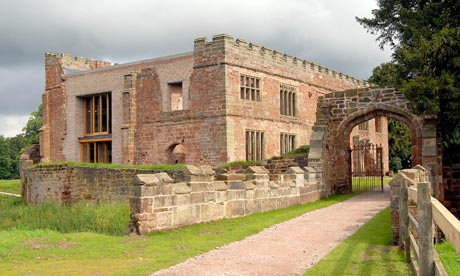
It's a commonplace daydream, being queen or king of your own castle, but one which usually founders on English Heritage opening times, impossible expense or the reality of using a garderobe lavatory cantilevered out of the walls.
Astley Castle has none of these disadvantages thanks to the sure hand of the Landmark Trust, magicians at rescuing apparently doomed ruins, and the skilful architectural practice they employed, Witherford Watson Mann.
Out of a fire-gutted shell which was an intermittent playground for vandals for 25 years, the two partners have created a contemporary pod within a framework of crumbled walls. Power showers, comfy sofas and underfloor heating coddle up to eight garrison members, amid extraordinary views of the Warwickshire countryside. As in George Herbert's hymn, you gaze first on floor-to-ceiling plateglass windows; then through them, to the shattered Gothic tracery of their medieval counterparts.
This inside-outside effect is the chief delight of a stay at Astley. The modern core, a rare departure for Landmark whose previous restorations have been obsessively faithful, is only part of the experience. Unless caught out by rain, you can – and surely will – choose to have meals in the roofless and broken-windowed hall with its roaring fire which warms the entire space even on cool nights.
The fire which did for Astley in 1978 forms the second great pleasure of a stay: the bond which naturally develops between you, the privileged if temporary castle-dweller, and passers-by who come exploring on the public footpaths which circle the outside of the moat. Within just a couple of days, it is easy to learn the ways of noblesse oblige. How hard-hearted would you have to be to turn away a keen photographer, or a couple of pensioners with their eager little grandson who wants to meet one of the castle's many supposed ghosts?
On an idyllic eight-mile walk to Church End via Ansley and back through Old and New Arley, we also met half-a-dozen locals who wistfully remembered the castle's rackety finale, before the fire, as a hotel. A retired quarryman who invited us into Ansley Welfare Club ("The best pint in the village, and the cheapest") had held his wedding reception there. Another recalled Larry Grayson, camp son of nearby Nuneaton, roistering at the bar. George Eliot visited more chastely. She was born a mile away.
"They've turned a castle into a council house," said our Ansley pal, but most local opinion is warmer about the transformation, which is also brilliantly and comprehensively explained in a set of large Landmark folders. Along with the visitors' book – leather-bound in viridian, gold-tooled and full of erudite and often marvellously-illustrated comments, these are a hallmark of the trust's properties.
The history ones are riveting, quoting a snooty heritage inspector when the castle was on its knees in the 1950s: "I hope this third-rate pub (with a bar in every room) and inhabited by a couple of uncouth peasants does not figure as a stately home in the lists."
Another has all the entries on the 10-strong redesign shortlist, showing how most were too fanciful or overbearing. The appeal of the winning pod is simplicity; not surprisingly, as Landmark finally took courage to unite old with new because of the success of their only modern property, the Anderton House built in 1969 near Barnstaple. Its architect Peter Aldington feels that it was "the nearest we got to an integration of inside and outside spaces", and that is exactly the achievement at Astley.
Landmark Trust properties are not cheap, and three nights even in the nadir of off-season will set you back nearly £800. But divide that between eight and consider that the money is brilliantly well spent on other restorations (Astley alone cost £2.5m); and everything at a trust property is absolutely tickety-boo.
On its island with a lockable iron postern gate on the bridge above the moat, the castle could beguile you for the whole length of your stay. But its surroundings are well worth exploring with superbly waymarked and maintained footpaths – thank you, Warwickshire county council – running through a fascinating mixture of farmland and former pit and quarry villages.
Both landscape and people reminded me of South Yorkshire, whose even lovelier countryside is so little-known because of the weight on the national imagination of its heavy industrial past. Friendliness abounds and so do scenes which no longer exist if you take your view of life from the media: meadows ablaze with wildflowers; boys out like Huckleberry Finn swimming in the little river which meanders down to Old Arley from Church End.
All around is that overlooked region, the Midlands, which some in both South and North claim does not exist. Astley is an excellent place to start putting such nonsense right, with Arbury Hall, canals, Twycross zoo, a vast second-hand bookshop and much else on the doorstep, and Birmingham, Stratford-upon-Avon, Warwick and Calke Abbey a short drive away.
• Astley Castle, sleeps eight, costs from three nights' weekend £784, four nights midweek £473, one week £1,005, landmarktrust.org.uk

